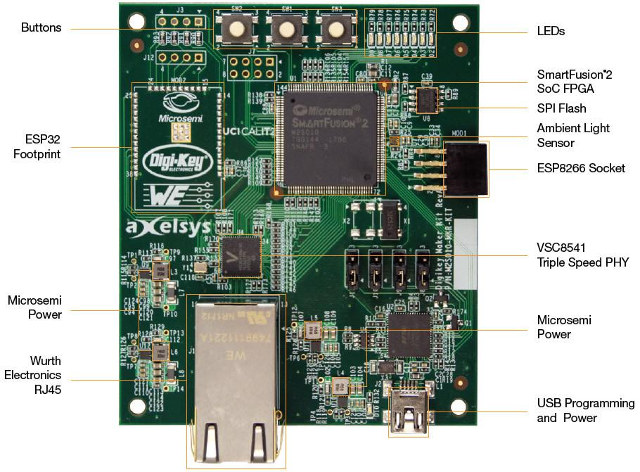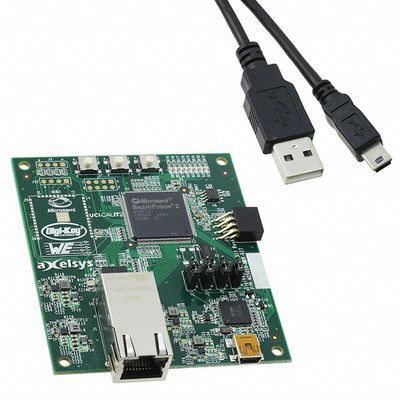Xilinx Zynq SoCs are probably the most well-known FPGAs with ARM cores, as their Cortex A9/A53 cores can run Linux, but they are not the only ones. Microsemi launched SmartFusion2 SoC comprised of FPGA fabric and an Arm Cortex-M3 core in 2013, as well as a $300 development kit.
The company has now partnered with Digikey to launch SmartFusion2 Maker Board, a low-cost evaluation platform for the SoC that comes with Gigabit Ethernet, a USB port, a connector for ESP8266 module, PCB footprint for ESP32 module, among other features like a light sensor, LEDs, and buttons.
SmartFusion2 maker board (M2S010-MKR-KIT) main features & specifications:
- SoC – Microsemi SmartFusion2 M2S010 SoC with:
- Arm Cortex-M3 @ 166 MHz, 6oKB+80KB eSRAM, 256KB eNVM
- FPGA with 12,084 logic element, 400 Kbits RAM
- Storage – 16 Mbit SPI Flash
- Connectivity
- Gigabit Ethernet via VSC8541 PHY, RJ45 connector
- Connector for ESP8266 (Sparkfun WRL-13678 – not included)
- Laid out footprint for ESP32 (DFRobot ESP-WROOM-32 – not included)
- USB (for programming/debugging) – USB integrated FlashPro5 programming hardware; USB port for UART communications
- Sensor – Ambient light sensor
- Misc – 8x user LEDs, 3x buttons including two user pushbuttons, 50 MHz clock source
- Power Supply – 5V via mini USB port; LX7167A PMIC
- Dimensions – N/A
The SmartFusion2 maker board can be used with Microsemi’s Libero SoC v11.8 or greater with a (Free) Silver license to program the FPGA fabric, and SoftConsole Eclipse based IDE to code the Arm Cortex M3 core in C/C++. You’ll find documentation on eewiki’s getting started guide.

The board – also known as M2S010-MKR-KIT – can be purchased for $33.75 through Digikey with close to 2,000 unit in stock at the time of writing. There may also be further information on the product page on Microsemi website.

Jean-Luc started CNX Software in 2010 as a part-time endeavor, before quitting his job as a software engineering manager, and starting to write daily news, and reviews full time later in 2011.
Support CNX Software! Donate via cryptocurrencies, become a Patron on Patreon, or purchase goods on Amazon or Aliexpress





